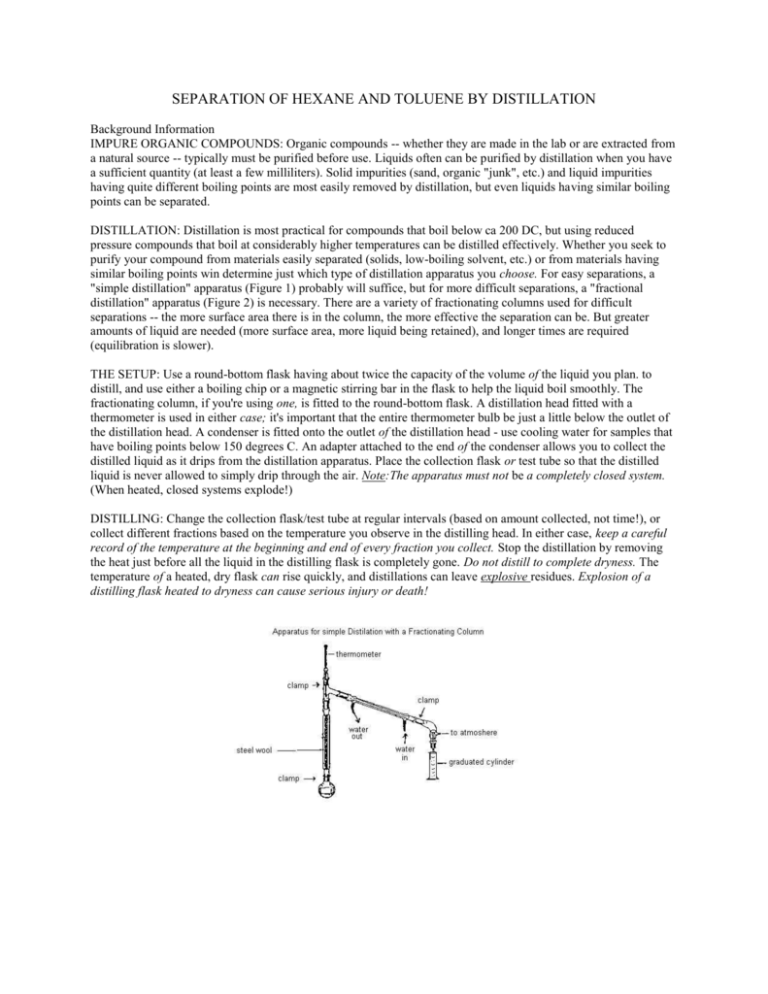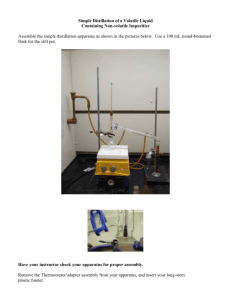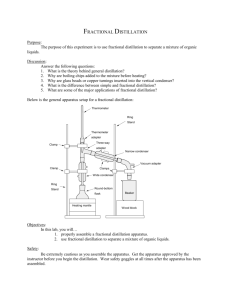Hexane And Toluene Distillation
advertisement

SEPARATION OF HEXANE AND TOLUENE BY DISTILLATION Background Information IMPURE ORGANIC COMPOUNDS: Organic compounds -- whether they are made in the lab or are extracted from a natural source -- typically must be purified before use. Liquids often can be purified by distillation when you have a sufficient quantity (at least a few milliliters). Solid impurities (sand, organic "junk", etc.) and liquid impurities having quite different boiling points are most easily removed by distillation, but even liquids having similar boiling points can be separated. DISTILLATION: Distillation is most practical for compounds that boil below ca 200 DC, but using reduced pressure compounds that boil at considerably higher temperatures can be distilled effectively. Whether you seek to purify your compound from materials easily separated (solids, low-boiling solvent, etc.) or from materials having similar boiling points win determine just which type of distillation apparatus you choose. For easy separations, a "simple distillation" apparatus (Figure 1) probably will suffice, but for more difficult separations, a "fractional distillation" apparatus (Figure 2) is necessary. There are a variety of fractionating columns used for difficult separations -- the more surface area there is in the column, the more effective the separation can be. But greater amounts of liquid are needed (more surface area, more liquid being retained), and longer times are required (equilibration is slower). THE SETUP: Use a round-bottom flask having about twice the capacity of the volume of the liquid you plan. to distill, and use either a boiling chip or a magnetic stirring bar in the flask to help the liquid boil smoothly. The fractionating column, if you're using one, is fitted to the round-bottom flask. A distillation head fitted with a thermometer is used in either case; it's important that the entire thermometer bulb be just a little below the outlet of the distillation head. A condenser is fitted onto the outlet of the distillation head - use cooling water for samples that have boiling points below 150 degrees C. An adapter attached to the end of the condenser allows you to collect the distilled liquid as it drips from the distillation apparatus. Place the collection flask or test tube so that the distilled liquid is never allowed to simply drip through the air. Note:The apparatus must not be a completely closed system. (When heated, closed systems explode!) DISTILLING: Change the collection flask/test tube at regular intervals (based on amount collected, not time!), or collect different fractions based on the temperature you observe in the distilling head. In either case, keep a careful record of the temperature at the beginning and end of every fraction you collect. Stop the distillation by removing the heat just before all the liquid in the distilling flask is completely gone. Do not distill to complete dryness. The temperature of a heated, dry flask can rise quickly, and distillations can leave explosive residues. Explosion of a distilling flask heated to dryness can cause serious injury or death! Safety Notes! Hexane and toluene are extremely flammable! Use NO flames during this lab. Hexane and toluene are toxic and must be used in well-ventilated space only. All materials must be discarded in the containers provided. Procedure Using a graduated cylinder, measure and combine in a 50 mL round-bottom flask 12 mL of hexane (boiling point = 68.7 °c) and 18 mL of toluene (boiling point = 110.°C), to give an initial mixture having a 40/60 composition of hexane/toluene. Using this round-bottom flask, assemble a fractional distillation apparatus similar to Figure 2. (There are several variations possible. Your T A will tell you about any specific modifications to this apparatus, depending on the available glassware.) Gently heat the distillation flask to bring the mixture to a boil -- slowly! Heat just enough to first wet the bulb of the thermometer and then to raise the level of the liquid in the distilling head to permit it and the accompanying vapors to move into the condenser. To achieve satisfactory separation, it is important to avoid heating to strongly. Collect the distillate in a graduated cylinder. Record the temperature in the distilling head when the first drop and the last drop are collected for each fraction. Pour the first 2 mL into a test tube, labeling it fraction I. Continue collecting distillate for fraction 2 as long as the temperature remains relatively constant (at or below approximately 70°C). When the temperature rises above approximately 70 °C (The temperature may actually drop when the hexane fraction is about complete.), begin collecting fraction 3. Begin collecting fraction 4 when the temperature has reached approximately 100°C. When the temperature levels off near the boiling point of toluene (111 °C), begin collecting fraction 5. In any case, stop heating the distilling flask once you have collected 25 mL or just before the distilling flask becomes dry, whichever happens first! Clean up When you are finished, pour the purified hexane in the container marked "Distilled Hexane", the purified toluene in the container marked "Distilled Toluene", and all hexane/toluene mixtures in the container marked "Hexane/Toluene Mixtures". Clean the distillation flask as needed. The other glassware used in the distillation apparatus should be clean. Remember: Nothing from this experiment goes down the drain in the sink! Report: Separation of Hexane and Toluene by Distillation Your Name: __________________________________ Your Lab Partner's Name: ____________________ TA: ___________________________ Lab Section: ______________________________ Fraction 1 Temperature range amount ___________ mL °C Fraction 2 Temperature range amount ___________ mL °C Fraction 3 Temperature range amount ___________ mL °C Fraction 4 Temperature range amount ___________ mL °C Fraction 5 Temperature range amount ___________ mL °C Questions 1. How effective was your distillation? (Compare the amounts and the purity of each of your fractions.) 2. What could you change (apparatus, procedure) to improve the effectiveness of this separation of hexane and toluene? 3. Would fractional distillation work well to purify I mL of a liquid? Why not? 4. When would you choose to do a simple distillation rather than a fractional distillation?






